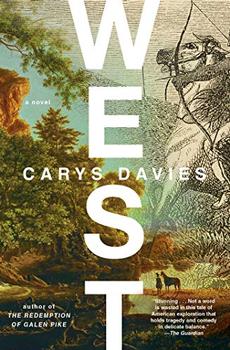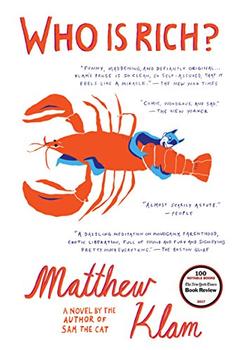Summary | Excerpt | Reviews | Beyond the book | Read-Alikes | Genres & Themes | Author Bio

A New American Journey
by Rinker BuckSo you're in your 60s and you feel like you're stuck in a rut, spinning your wheels. You're looking for a path, a trail to blaze. And then, during a visit to a roadside museum in the Midwest, you have a revelation: you see your destiny. Oddly, it too involves a rut, and spinning your wheels, a path, and a trail to blaze.
But you're not simply trading one kind of enervation for another. Instead of being saddled with despair, you'll be doing the saddling. And for the next several months, the ups and downs of life will be felt more acutely than you've ever felt them.
In a covered wagon, while riding slowly out in the open air, every blade of grass, every fence post and farm, or the mallard ducks rising from the streams, assumes a visual and olfactory intensity that you can never feel while trapped inside a speeding car. While on a wagon seat, the land embraces you, emotionally. The rumbling wheels, the creaking top, and the pull of the driving lines in your hands multiply the pleasure of travel…no other form of travel could match it.
That epiphany comes from Rinker Buck, a journalist who hatched the idea a couple of years ago of following the legendary pioneer route known as the Oregon Trail – still marked in places with the ruts imprinted by generations of settlers – in a covered wagon. In 1843, 120 wagons with an estimated 700 to 1,000 migrants made the trek, and the event was subsequently referred to as "The Great Migration of 1843." Historians estimate that almost 400,000 pioneers crossed the trail in the decades before the Civil War (see 'Beyond the Book'). Buck's account of his travels, The Oregon Trail: An American Journey, is an illuminating – if a bit exhausting – chronicle of the joys and hardships of his quest to see America slowly.
Accompanied by his brother Nick, an unemployed construction worker and accomplished horseman, Buck embarks on the "completely lunatic notion" of lurching by mule-pulled wagon across the 2,100-mile original trail, "even where it has been covered over by modern highways or railroad tracks." Buck often found himself and his wagon to be an anachronistic amusement along the nation's western highways. Modern development has claimed much of the trail, supplanting it with shopping centers and housing development, as well as miles of interstate. However, the majority of the stretch still winds through the pristine prairies, wilderness, and deserts that comprised the original Oregon Trail.
The several-months-long journey ostensibly begins in St. Joseph, Missouri, but for Buck, whose father was an eccentric amateur adventurer, the journey really began in his boyhood, during his family's covered-wagon camping trips through New Jersey and Pennsylvania in the 1950s: "I had told myself that I was out on the trail seeking adventure, knowledge of an epic era of American history, proof that a modern crossing could still be done. But now, as Kansas slowly passed by, with the clopping of hooves and the ringing of harness acting as a neuroenhancer, I knew that I was also out here seeking my past."
The psychic landscape of childhood travel is familiar terrain to Buck, whose previous nonfiction book Flight of Passage chronicled, 30 years after the fact, a 1966 cross-country series of flights he piloted with another brother, both of them teenagers at the time, making them the youngest pilots ever to traverse the continent. But his current journey isn't borne of youthful idealism so much as middle-aged ennui: "I had stayed too long at my job…mostly owing to my own mistakes, my marriage had ended and I had moved out of my house." Somewhat in the spirit of the original pioneers, he needed a fresh start: "I had become that familiar subspecies of the North American male, the divorced boozehound with a bad driving record and emerging symptoms of low self-esteem. I knew that I had to escape again – this time in a big way."
A team of mules and a 2,100-mile overland trail would certainly seem to qualify. The not-unexpectedly-arduous journey for Buck turns into mostly a pleasure trip for the reader, who will discover two books within The Oregon Trail. The first deals with the day-to-day chugging along of Buck's covered wagon across the rocky, rolling plains, and the second (and, perhaps surprisingly, much more interesting) offers a historical re-examination of life along the Oregon Trail.
Buck is a mildly diverting memoirist, and the chronicle of his personal adventure is not without its moments – though it does suffer from a certain monotony, as only so much narrative momentum can be generated through the recitation of the daily tasks of hitch the mules, steer the wagon, find a campsite, unhitch the mules, cook dinner, sleep under the stars. But his research into the teeming and turbulent existence of the original Oregon Trail pioneers is utterly riveting, from his discussions of how to choose the perfect mule for wagon transport to the ravages of cholera along the trail.
Punctuated generously with pioneers' diary excerpts, Buck recaptures the terror and thrill of wagon train travel when there were few guides or maps to assure the uncertain but mostly unshaken zealots who braved Indian attacks, starvation, drowning, or disappearance without a trace. As he wryly notes, "In the vast West, the sensation of being lost usually arrives long after you are lost."
Buck's regular attempts to portray his own journey as fraught with the same sorts of challenges faced by the nineteenth century's trailblazers don't quite come off (given his cell phone, state-of-the-art camping gear, and fairly frequent encounters with friendly ranchers and even occasional trips to the hardware store). But his many uncomfortable hours bouncing along in his wagon do engender some affecting insights into what the Oregon Trail represents: "The trail experience had clarified our destiny and national character…The ruts crossing the plains had not only physically connected a finished continental space, but spiritually cohered a young country's first principles into a national psyche."
Buck's psyche seems to have been renewed as well, the conclusion of the trip reminding him that "passion is the staple of life and persistence its nourishing force." There are, very likely, some easier ways to arrive at that idea for those suffering from a mid-life crisis. But for the original travelers astride that fresh scar of land called the Oregon Trail, passion and persistence were not only necessary to renew their spirits but also to keep them alive.
![]() This review was originally published in The BookBrowse Review in August 2015, and has been updated for the
June 2016 edition.
Click here to go to this issue.
This review was originally published in The BookBrowse Review in August 2015, and has been updated for the
June 2016 edition.
Click here to go to this issue.

If you liked The Oregon Trail, try these:

by Carys Davies
Published 2019
An exquisite, slender first novel set on the American frontier about a restless widower who heads west on a foolhardy and perilous expedition in search of unknown animals, leaving his intrepid young daughter behind to fend for herself at home.

by Matthew Klam
Published 2018
A provocative satire of love, sex, money, and politics that unfolds over four wild days in so-called "paradise" - the long-awaited first novel from the acclaimed author of Sam the Cat.
People who bite the hand that feeds them usually lick the boot that kicks them
Click Here to find out who said this, as well as discovering other famous literary quotes!
Your guide toexceptional books
BookBrowse seeks out and recommends the best in contemporary fiction and nonfiction—books that not only engage and entertain but also deepen our understanding of ourselves and the world around us.